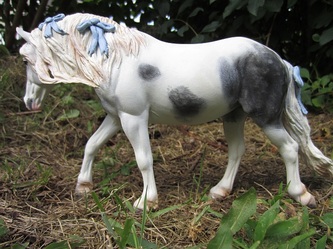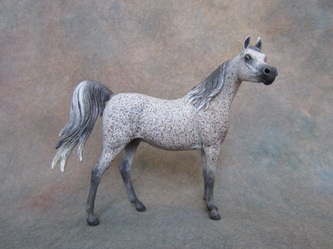I’m thrilled to
introduce my readers to my uber-talented cousin Stacey Kianese. Stacey
customizes model horses, taking them from static, cookie-cutter resin figurines
to miniature works of art. Her models have NAN-qualified and earned numerous
championship ribbons. (View Stacey's gallery.)
Stacey blogs about
custom model horse painting and showing at Trillium Studio.
Her blog posts
frequently wax eloquent about the vagaries of her hobby and the subjective
nature of showing one’s art in competition. They contain so many parallels to
the Wonderful World of Writing that they made me realize how closely all
creative endeavors are related – up to, and including, the occasional
self-doubt that seems to plague every artistic soul. Though the medium may
differ, the journey is the same.
Stacey’s passion for her art inspires me. I trust it will you as well…
Q: How did you
get started modifying, sculpting, and painting model horses?
A: I collected
Breyer horses way back when I was a kid and I always loved them. Those horses
are long gone. Back in 2008, I was on Ebay and I somehow came across a
customized Breyer and was blown away with how cool it was. I was shocked to see
how much money it was going for. I did a Google search, which lead me to
various web sites, blogs, etc. and as they say, the rest is history.
Q: The model
horse world has its own language and acronyms just as the publishing industry
does. Can you provide a quick lexicon of common terms for those unfamiliar with
the hobby?
A: Here's a quick
summary.
- RR - regular run. This is a horse right out of the box, direct from the manufacturer.
- OOAK - one of a kind.
- LR/SR - limited/special run.
- CM - custom. A custom can be as simple as a straight repaint or as complex as completely hacking the model apart and resculpting it.
- AR - artist resin. These are limited runs purchased directly from a sculptor. They are not cheap, LOL. They are very addictive and are usually way more detailed than your store-bought Breyer. Some highly sought after resins can go for over $1,000. They are also sold unpainted, so in addition to buying the resin, you would have to commission an artist to paint it. This is also expensive and why I developed my skills so I didn't have to worry about commissioning somebody.
Show holders can submit an application to NAMHSA (North
American Model Horse Shows Association) to have their show NAN approved. This
means 1st and 2nd place horses will get a NAN card and are eligible to show at
NAN (North American Nationals). You can get a card in Breed,
Collectability, Workmanship, and Performance.
Q: What are some of the things you have learned
from your hobby?
A: I have learned
so much about horses by showing. You have to know what colors are acceptable in
certain breeds. For example: no Appaloosa-like spots or blankets on
Saddlebreds; no roan Morgans; and no buckskin Arabians.
I’ve also learned that you don’t have to be rich to be
competitive. A lot of people spend big bucks on their models, but you don't
have to. I bought a little Arabian stablemate for a buck at a horseshow
because I felt sorry for it. I took him to a show and threw him on the
table as a joke and he got 4th in a class of 20+ horses last year.
And, of course, I’ve learned that there is no such thing as
a “sure thing.” Sometimes I find that the horses I think will kick butt don't
place and the ones I bring just to put something on the table get the blues!
A: For me, my
biggest thrill is taking a blank resin and transforming it to a lifelike
horse. Taking care to paint the markings in the correct growth pattern,
detailing the eyes and hooves, achieving a realistic coat color -- it's
GREAT!
I work in pastel pigments but some people work in oils or
acrylics. Pigments are pretty messy and take a lot of patience but I feel
that medium gives the most realistic depth of color.
There are many steps involved in getting the horse ready for
paint. You have to sand/scrape off seams, you have to bathe the model in
Ajax to get rid of any release that may be on the resin, and you have to put a
coat or two of primer on it so your medium will stick. Crappy prep job = crappy
model, so prepwork is important. That is why I am so geeked whenever I
get ribbons in workmanship classes.
Q: The process of
submitting your work for judging is a bit like that of a writer submitting a
manuscript for publication. How do you maintain a positive attitude in a highly
competitive hobby?
A: I’ve been
known to have a crisis of artistic confidence. It's nice to hear somebody other
than your spouse / family likes your stuff. We all know that! Nothing
sucks more than to have a model up on the table that you've put your heart and
soul into, and the judge doesn't even look at it. Aarrgh!
The thing I keep telling myself is: it is all a matter of
opinion. Some judges just don't like sculpts by certain artists. Some
judges don't like certain colors. Some judges don't like certain breeds. It
just depends on what is on the table and who is judging.
Then there is the cliquey thing. Nobody likes to admit
it but if the judge knows you and likes your stuff, they'll pin you. Also,
if it is a popular mold, done by a "big name artist," it has a pretty
good chance of getting pinned.
I think my biggest problem is I have high expectations.
Perhaps too high. I was talking with another hobbyist about
"only" placing third. Woe is me! Waaa! She put
it into perspective for me, telling me the class was large and there were some
pretty big name painters on the table. She then went on to
say she would have been thrilled with a third. That was my
"A-Ha!" moment when I realized maybe I was being just tad harsh on
myself.
I don't do commissions. Period. Too much pressure. What I do
like to do, however, is donate items to shows, swap customs with fellow
hobbyists, and sell stuff on Ebay once in a while. Though ribbons and sales are
nice, they’re just the icing on the cake. The real fun is in bringing your
vision to life, making something that has never been made before. I have a lot
of ideas a-brewing and I can’t wait to get cracking!




